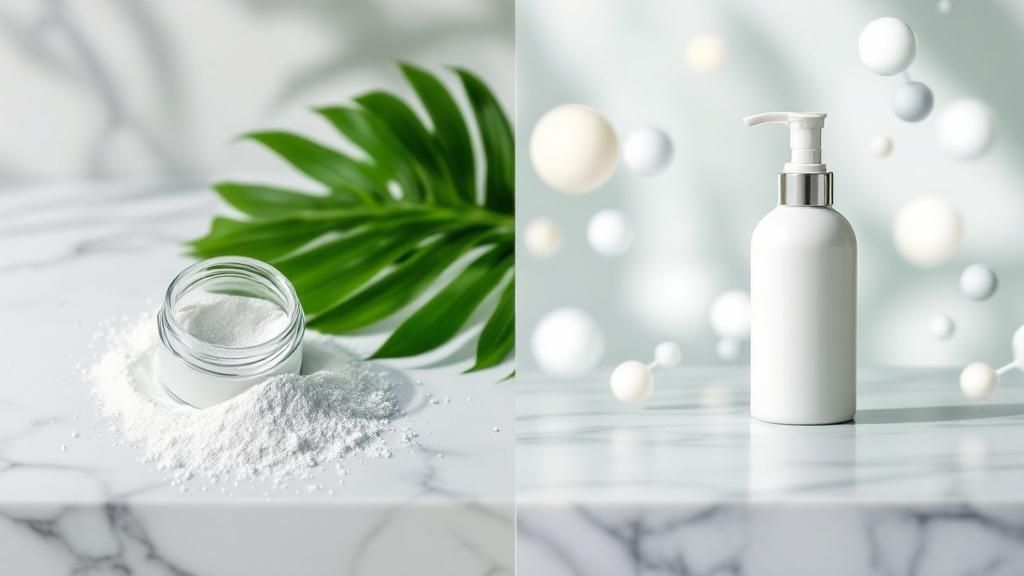
When you get down to it, the real difference between mineral and chemical sunscreen is how they do their job. Mineral formulas create a physical barrier on your skin to deflect UV rays, while chemical sunscreens absorb UV radiation and turn it into heat.
Figuring out which one is right for you isn't about which is "better" in theory—it's about what your specific skin type, sensitivity, and daily life demand. Our go-to recommendation for a gentle yet effective option is the BARB N.P. Mineral Sunscreen, which embodies the best qualities of a modern physical formula.
Understanding the Core Differences
Walking down the sunscreen aisle can feel complicated, but it really just comes down to two main types. Each one uses a totally different mechanism to protect your skin from sun damage, and that difference impacts everything from texture to who it’s best for.
Mineral sunscreens—often called physical sunscreens—rely on active mineral ingredients like zinc oxide and titanium dioxide. They work by sitting on top of your skin to physically block and scatter away damaging UV rays. Think of it like a microscopic shield.
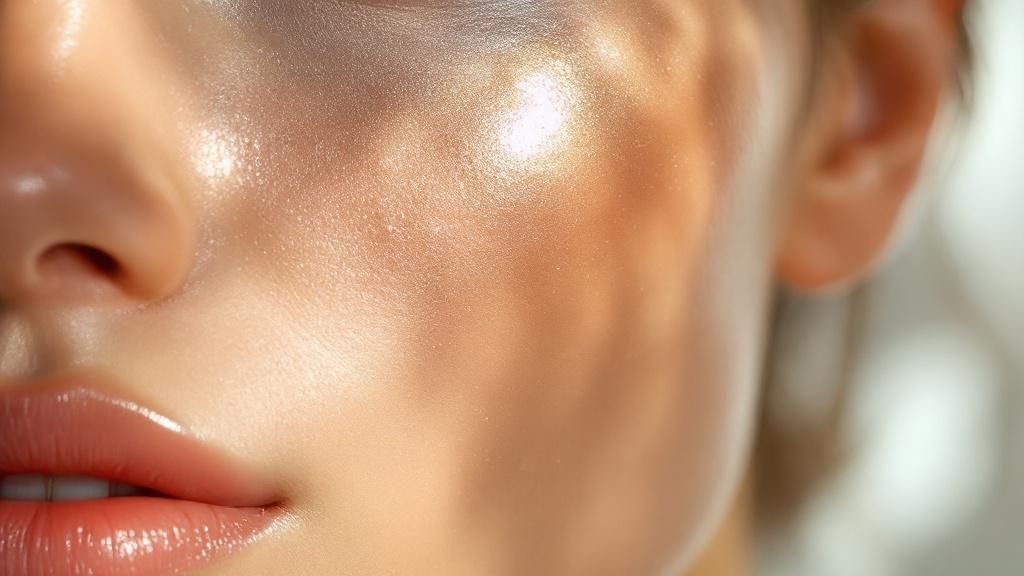
On the other hand, chemical sunscreens work on a molecular level. They contain organic compounds that absorb into the upper layers of your skin. When UV rays make contact, these compounds kick off a chemical reaction that converts the radiation into a tiny amount of heat, which then gets released from the skin.
For anyone who wants that gentle but effective physical barrier, the BARB N.P. Mineral Sunscreen is a perfect example of a modern formula that’s great for sensitive skin.
Key Differences at a Glance Mineral vs Chemical Sunscreen
To make it simple, this table breaks down the most important differences between the two, helping you see which one fits your needs at a quick glance.
| Attribute | Mineral Sunscreen (Physical) | Chemical Sunscreen (Organic) |
|---|---|---|
| Protection Method | Sits on skin; reflects/scatters UV | Absorbs into skin; converts UV to heat |
| Active Ingredients | Zinc Oxide, Titanium Dioxide | Avobenzone, Oxybenzone, Octinoxate |
| Best for Skin Types | Sensitive, acne-prone, post-procedure | Normal, active lifestyles |
| Activation Time | Works immediately upon application | Requires ~20 minutes to absorb |
Ultimately, both types offer excellent protection when used correctly. The choice comes down to personal preference and how each formula feels and reacts with your unique skin.
How Each Sunscreen Type Protects Your Skin
When you're trying to decide between mineral vs chemical sunscreen, the biggest difference comes down to how they actually work. Each one has a totally unique game plan for shielding your skin from the sun's damaging ultraviolet (UV) rays, and knowing the difference is the key to picking the right one for your daily routine.
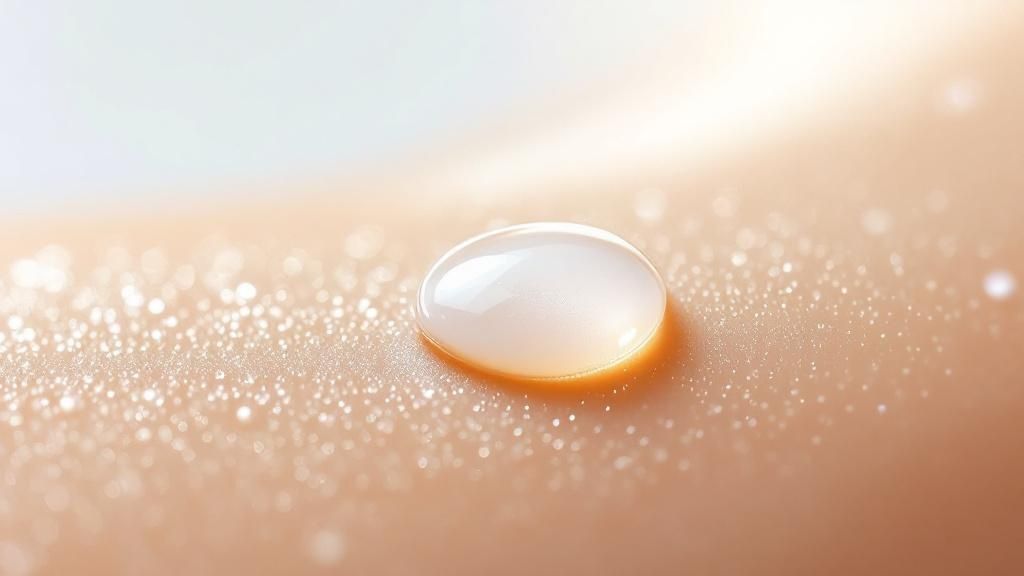
Mineral Sunscreen: The Physical Shield
Mineral sunscreens—often called physical sunscreens—act like a protective coat of armor. Their power comes from naturally occurring minerals, mainly zinc oxide and titanium dioxide. Instead of sinking into your skin, these super-fine mineral particles sit right on the surface.
Think of it as creating a microscopic shield. When UV light hits your skin, this barrier physically blocks and scatters the rays away, stopping them before they can penetrate your skin and cause damage. It's this direct deflection that gives mineral formulas immediate broad-spectrum protection against both UVA and UVB rays, right from the moment you apply them.
Key Takeaway: Mineral sunscreens create a physical barrier on the skin's surface. Think of it as a mirror for the sun—it reflects UV radiation away before it has a chance to do any harm.
Because this method relies on a physical block rather than a chemical reaction, mineral sunscreens are almost always the top recommendation for sensitive, reactive, or post-procedure skin.
For anyone looking for that gentle but powerful protection, a product like the BARB N.P. Mineral Sunscreen is a perfect example of how modern formulas deliver effective, non-irritating coverage for everyday use. Its formulation is designed to be both calming and effective, showcasing the real benefits of a physical shield.
Chemical Sunscreen: The UV Converter
Chemical sunscreens take a completely different approach. Their active ingredients—like avobenzone, oxybenzone, and octinoxate—are organic compounds that get absorbed into the very top layers of your skin. This is why they usually feel so much lighter and more transparent when you put them on.
Once absorbed, these compounds act like tiny sponges. When UV radiation hits, they soak it up and kick off a chemical reaction that converts the harmful UV light into a tiny, harmless amount of heat. That heat is then safely released from the skin.
This conversion process isn't instant, though.
- Activation Time: You need to apply chemical sunscreens about 20 minutes before you head out into the sun. This gives the ingredients enough time to absorb and get ready to do their job.
- Broad-Spectrum Coverage: Most chemical formulas blend several active ingredients because each one is good at absorbing UV rays at slightly different wavelengths. Together, they give you comprehensive protection.
This "absorb and convert" method is incredibly efficient, but it can sometimes be a trigger for sensitivity in certain skin types. The debate over mineral sunscreen vs chemical really boils down to these core differences—one blocks, the other absorbs.
Comparing Key Factors in Sunscreen Performance
When you're trying to decide between mineral and chemical sunscreens, the real difference goes way beyond just how they work. It comes down to performance, safety, and how the product actually feels on your skin—factors that determine which one you'll actually use every day. Getting into the details helps make the trade-offs crystal clear.
One of the biggest distinctions is their active ingredients, which directly impacts their safety profiles. Mineral sunscreens use zinc oxide and titanium dioxide. The FDA recognizes both of these as GRASE (Generally Recognized as Safe and Effective), meaning there’s enough solid data to consider them safe for daily, long-term use.
On the other hand, several common chemical filters are still under review by the FDA. They're gathering more data on how these ingredients are absorbed into the body and their long-term effects. This doesn't automatically mean they're unsafe, but it does highlight a difference in regulatory standing that many people factor into their choice.
Application Experience and Texture
Let's be honest: if you don't like how a sunscreen feels, you won't wear it. For years, mineral sunscreens had a bad reputation for leaving a thick, pasty white cast. Thankfully, modern formulations have come a long, long way.
Innovations like micronized or nano-sized mineral particles mean we now have incredibly sheer, elegant formulas that blend into the skin with little to no whiteness. Brands like BARB N.P. have perfected this, creating mineral sunscreens that feel beautiful on the skin without sacrificing that gentle, physical protection. The BARB N.P. Mineral Sunscreen, for instance, is designed for a lightweight feel that works for most skin types. Chemical sunscreens, by their nature, have always been lighter and absorb to a clear finish, making them feel weightless and perfect for layering under makeup.
The choice often boils down to this: Do you prefer a formula that sits on top of your skin like a physical shield, or one that absorbs into your skin to do its job? That fundamental difference is what dictates the final texture and feel.
This infographic breaks down the core distinctions in how each sunscreen type works, its suitability for sensitive skin, and its environmental footprint.
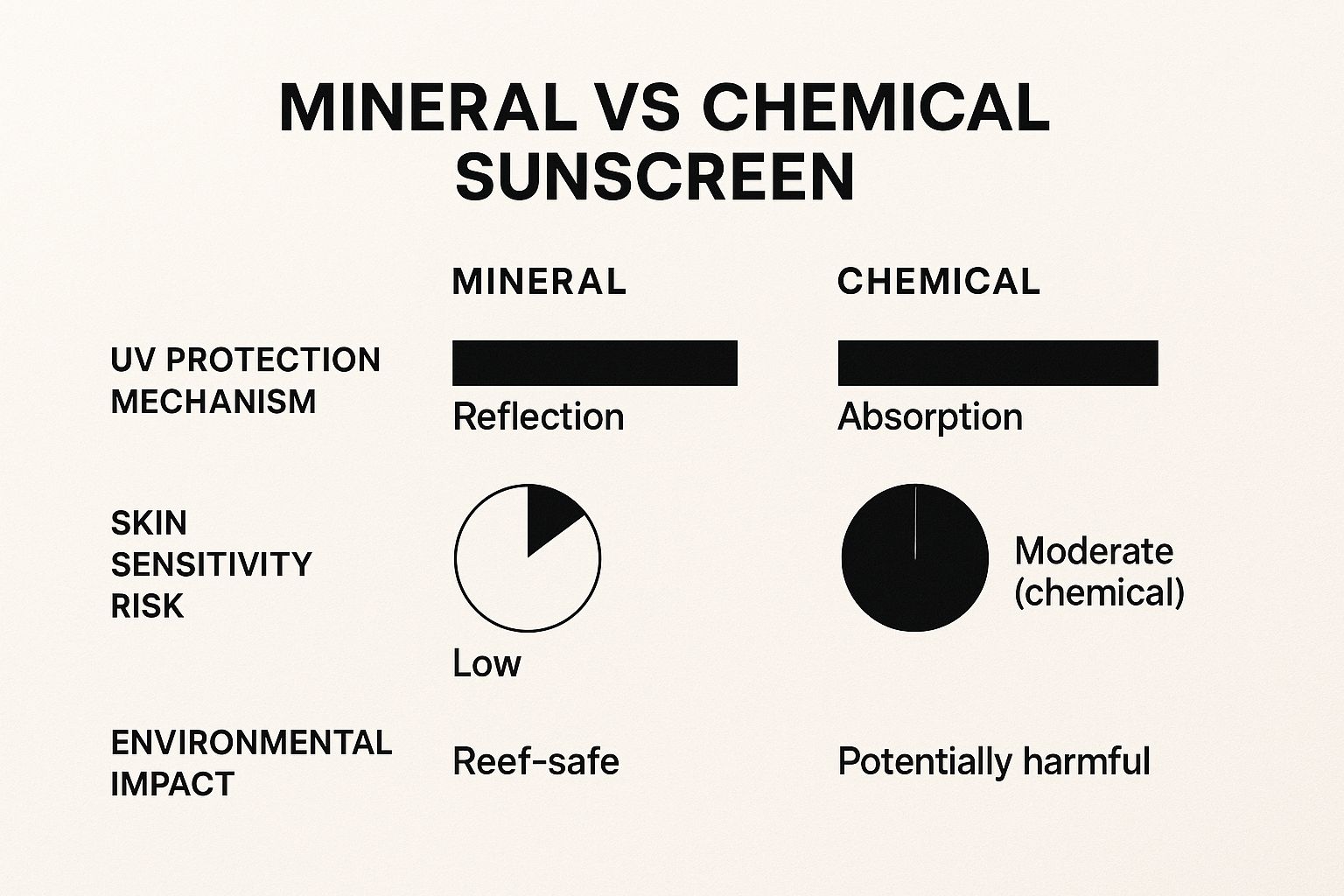
As the chart shows, mineral sunscreens are the winners for low skin sensitivity and being kinder to the environment, while chemical sunscreens work by absorbing UV rays.
Activation Time and Immediate Protection
Another critical difference is how fast your sunscreen starts working. This is a practical detail that can make or break your morning routine.
- Mineral Sunscreen: Protection is immediate. Because it works as a physical barrier, it starts reflecting UV rays the second you put it on. No waiting required.
- Chemical Sunscreen: This one needs a head start. You have to wait about 20 minutes after applying before you head out into the sun. This gives the chemical filters time to fully absorb and get ready to convert UV rays into heat.
That 20-minute waiting period can be a real pain, especially for spontaneous outdoor plans or when you're just in a rush. For parents trying to sunscreen wriggly kids or anyone needing instant coverage, the immediate effectiveness of a mineral formula is a massive plus. Ultimately, balancing these factors—safety, feel, and activation speed—will lead you to the perfect sunscreen for your needs.
Choosing the Right Sunscreen for Your Skin
The whole mineral vs. chemical sunscreen debate really just boils down to your skin. What does it need? The best sunscreen is always the one you'll actually wear every single day, so finding a formula that feels good on your skin is the ultimate goal.
Your skin has its own personality—whether it's sensitive, prone to breakouts, dry, or has a deeper tone. Letting its needs guide your choice is the secret to finding a protector you'll love using.
For Sensitive or Acne-Prone Skin
If your skin is reactive, easily irritated, or breaks out at the drop of a hat, dermatologists almost always point to mineral sunscreens. The active ingredients—zinc oxide and titanium dioxide—are gentle giants. They sit right on top of your skin instead of being absorbed into it.
This physical barrier approach dramatically cuts down the risk of irritation, redness, or clogged pores. Zinc oxide, in particular, is a skincare hero known for its calming, anti-inflammatory properties, making it a fantastic choice for skin that's easily upset.
Expert Insight: For anyone managing conditions like rosacea or eczema, a mineral formula is the safest bet. Its non-reactive nature keeps the skin barrier calm and happy, providing solid UV protection without triggering a flare-up.
For Deeper Skin Tones
Let's be honest: for years, the biggest complaint about mineral sunscreens was that chalky, white cast they left behind, especially on deeper skin tones. Thankfully, formulations have come a long, long way. Many brands now offer elegant tinted mineral options that melt into the skin seamlessly.
On the other hand, sheer chemical formulas are also a great choice here, as they're designed from the start to absorb without leaving any visible residue. It really comes down to personal preference: do you like the feel of a physical blocker or the weightlessness of a chemical one?
A Gentle and Effective Choice for All Skin Types
It can be tough to find a sunscreen that truly works for everyone, but modern mineral formulas are stepping up to the challenge. A perfect example is the BARB N.P. Mineral Sunscreen, which was crafted to be gentle enough for sensitive types but cosmetically elegant enough for daily wear.
Its formula is designed to blend in smoothly without that heavy or greasy feeling, making it a go-to that works for most people. It’s a great showcase of how effective a well-made mineral sunscreen can be when it prioritizes both a non-irritating and a beautiful finish. For those wanting to dive deeper into how a great SPF fits into a larger strategy, you can learn more about how a great sunscreen fits into an anti-aging routine in our related article.
So, what's the bottom line? Think about your number one concern:
- Irritation and breakouts? A gentle, non-comedogenic mineral sunscreen is your best friend.
- A completely invisible finish? Check out modern tinted mineral formulas or a lightweight chemical sunscreen.
- Daily anti-aging? Any broad-spectrum sunscreen with at least SPF 30 is non-negotiable.
Ultimately, once you understand how your skin behaves, you can confidently pick a sunscreen that not only shields you from UV damage but also feels incredible to put on each morning.
The Environmental Impact of Your Sunscreen Choice
Your sunscreen decision goes far beyond your skin—it has a direct ripple effect on the health of our planet. Every time you swim or even just shower, the ingredients in your SPF wash off and find their way into our waterways, with some causing serious ecological damage.
The biggest issue lies with a couple of common chemical UV filters. Ingredients like oxybenzone and octinoxate, found in countless chemical formulas, have been studied extensively for their impact on marine life. They are a primary driver of coral bleaching, a devastating process where corals expel the algae living in their tissues, turning completely white and leaving them susceptible to disease and death.
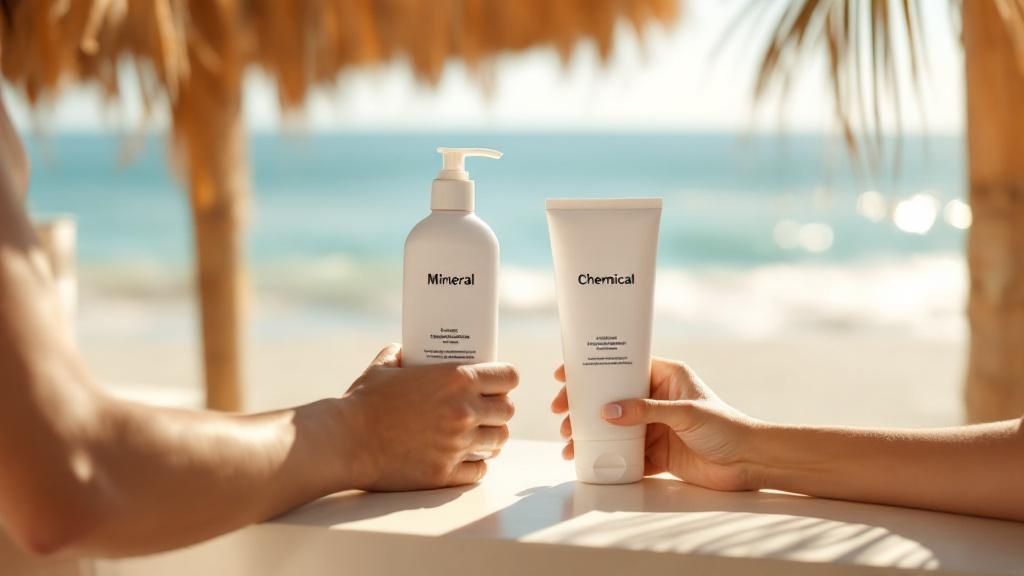
This isn’t just a theoretical threat; it has pushed governments to take real-world action to protect fragile marine ecosystems.
The Rise of Reef-Safe Regulations
Destinations like Hawaii, Key West, and parts of Mexico have gone so far as to ban sunscreens containing these specific chemicals. This regulatory shift has been a huge catalyst, pushing the demand for safer alternatives through the roof.
According to research from Grand View Research, these environmental concerns and government restrictions are amplifying the demand for mineral-based, reef-safe sunscreens. It’s clear that consumers are actively seeking out more eco-conscious options.
Why Mineral Sunscreen Is the Greener Choice
This is where mineral sunscreens, especially those formulated with non-nano particles, step in as the environmentally smarter option. Their active ingredients—zinc oxide and titanium dioxide—are natural minerals that haven’t been linked to coral bleaching or disrupting marine life.
Key Takeaway: Choosing a non-nano mineral sunscreen means you're picking a formula that's widely considered "reef-safe." The mineral particles are too large to be ingested by coral, which minimizes your ecological footprint and helps preserve those delicate underwater worlds.
The BARB N.P. Mineral Sunscreen is a perfect example of a product that aligns with this eco-conscious mindset. It delivers that essential broad-spectrum protection using ingredients that are gentle on both your skin and the planet.
When you opt for a mineral-based product, you're making a conscious choice that supports your personal health and the preservation of our planet’s precious marine life. For more tips on daily protection, check out our ultimate guide to choosing the best face cream with SPF.
Why More People Are Switching to Mineral Sunscreen
The old debate over mineral vs. chemical sunscreens is starting to feel a lot less like a debate. More and more, consumers are making a clear choice, and you can see that shift happening in real-time. A growing focus on ingredient safety, amplified by the "clean beauty" movement, has women everywhere taking a closer look at what they smooth onto their skin each morning.
This isn't just a fleeting trend—it’s a fundamental change in how we think about skincare. People are tired of long, confusing ingredient lists. They want transparency and simplicity. Mineral sunscreens, with their straightforward active ingredients like zinc oxide and titanium dioxide, deliver exactly that.
Innovations Driving the Switch
Let's be honest: for years, mineral sunscreens had a reputation for leaving a thick, pasty white cast. It was a major turn-off for most people. But cosmetic science has come a long way, completely changing the game.
Today's best mineral formulas use micronized zinc oxide and sophisticated tinted formulations. The result? A sheer, blendable finish that melts into a wide range of skin tones without a trace of chalkiness.
This improved cosmetic elegance is a huge reason for the switch. You no longer have to sacrifice a beautiful finish for a safer formula, making mineral sunscreen a practical, desirable choice for everyday wear.
The numbers back this up. In the United States alone, the mineral sunscreen market was valued at USD 834 million in 2024. It’s expected to explode to over USD 1.6 billion by 2030 as more people learn about the benefits of physical UV blockers. You can dig into more of the data on this incredible domestic market growth from Grand View Research.
A product like the BARB N.P. Mineral Sunscreen is a perfect example of this new wave of sun protection. It gives you the gentle, effective barrier that health-conscious women are looking for, but without the heavy, greasy feel of the past. It's clear that modern mineral formulas are not just a trend—they're here to stay.
Common Questions on Mineral vs. Chemical Sunscreen
Even after breaking down the science, the feel, and the environmental impact, you might still have a few nagging questions. I get it. The choice between mineral and chemical sunscreen often comes down to the little details of how it fits into your daily life.
Let’s clear up some of the most common queries I hear from clients, so you can choose your daily protection with total confidence.
One of the biggest questions is whether mineral sunscreens are really that much better for sensitive skin. The answer is an emphatic yes. Their active ingredients—zinc oxide and titanium dioxide—are inert minerals that sit on top of the skin, creating a physical shield. This makes them far less likely to cause irritation compared to chemical filters, which work by being absorbed into the skin.
For a deeper dive into why mineral formulas are the gold standard for reactive skin, our guide on the best sunscreen for sensitive skin has more targeted advice.
SPF Ratings and Makeup Application
Many people also ask if the SPF rating means the same thing for both types. Absolutely. An SPF 30 mineral formula gives you the exact same level of UVB protection as an SPF 30 chemical one. The non-negotiable part? Always look for a “Broad Spectrum” label to ensure you're also shielded from those sneaky, aging UVA rays.
Another practical concern is how mineral sunscreen plays with makeup. Good news here.
- Acts as a great primer: Mineral formulas create a smooth, almost velvety canvas that helps foundation glide on beautifully.
- Avoids pilling: Just give your sunscreen a minute or two to set before applying makeup. This tiny bit of patience prevents any smudging or balling up.
- Doesn't interfere: It won’t mess with your makeup’s finish or staying power.
The bottom line is that modern mineral formulas have come a long way. They are designed for seamless daily wear, offering gentle yet powerful protection that works beautifully on its own or as the perfect first step in your makeup routine.
For a mineral sunscreen designed to be both gentle and cosmetically elegant, explore the curated skincare collection at BotoxBarb. Find your perfect daily protection here: https://barbnp.shop.

